Analysis of Toyota Motor Corporation's Supply Chain Management
VerifiedAdded on 2023/05/29
|14
|3650
|106
Report
AI Summary
This report provides an in-depth analysis of Toyota Motor Corporation's supply chain and logistics management, focusing on its core strategies and operational effectiveness. The report begins with an overview of the company, its history, and its position in the automotive industry. It then delves into the analysis of Toyota's supply chain, highlighting the significance of the Toyota Production System (TPS) and Just-in-Time (JIT) manufacturing. The report further examines key areas such as quality management, emphasizing Toyota's commitment to customer satisfaction and continuous improvement, and people management within operations and supply chains, exploring the strategic decisions and productive measures employed. The analysis also includes an examination of Toyota's triple bottom line approach, considering environmental, social, and financial aspects. The report concludes with recommendations and insights into the challenges faced by Toyota and how it maintains its competitive advantage in the global market. This comprehensive overview is valuable for students studying operations, logistics, and supply chain management.
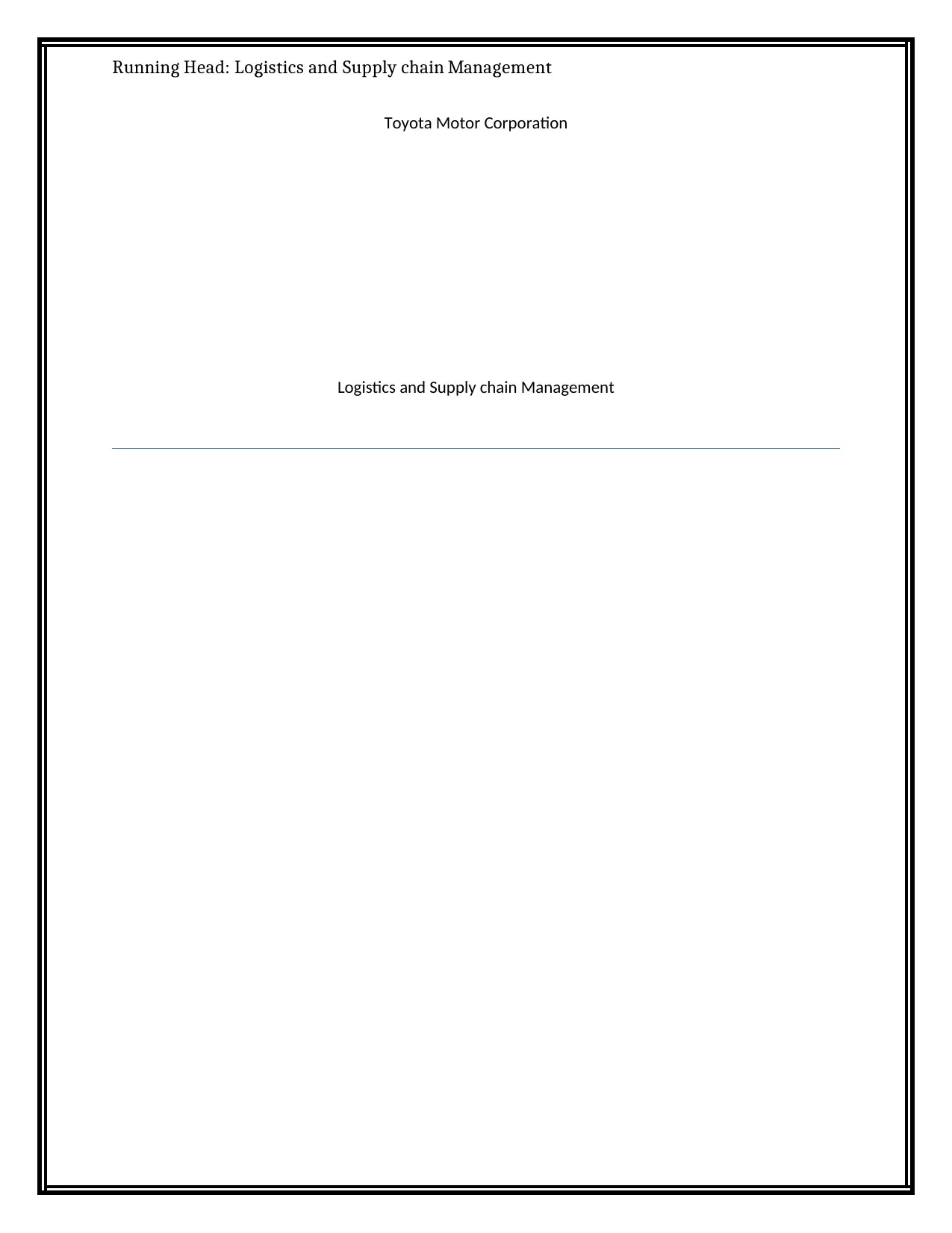
Running Head: Logistics and Supply chain Management
Toyota Motor Corporation
Logistics and Supply chain Management
Toyota Motor Corporation
Logistics and Supply chain Management
Paraphrase This Document
Need a fresh take? Get an instant paraphrase of this document with our AI Paraphraser
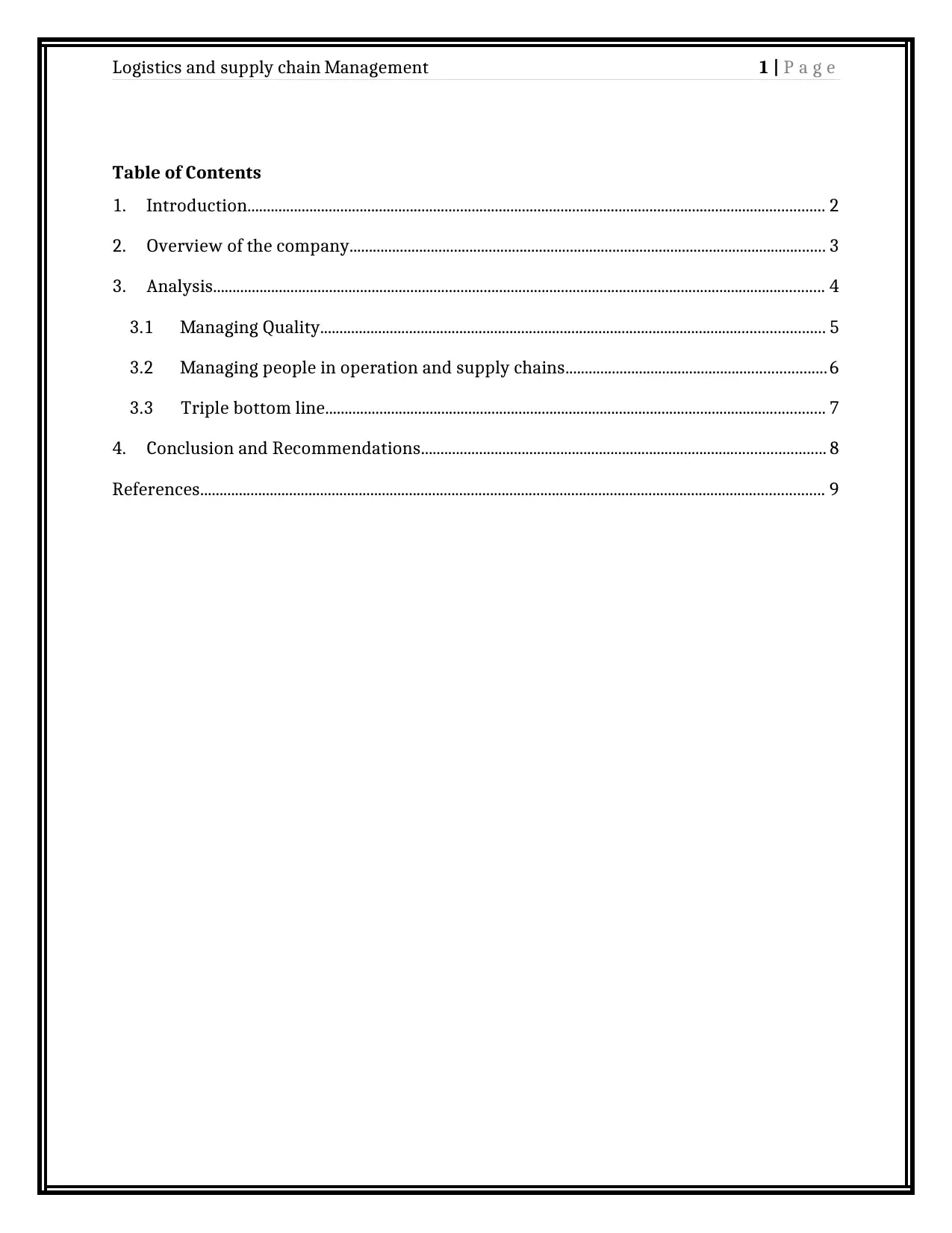
Logistics and supply chain Management 1 | P a g e
Table of Contents
1. Introduction..................................................................................................................................................... 2
2. Overview of the company........................................................................................................................... 3
3. Analysis.............................................................................................................................................................. 4
3.1 Managing Quality.................................................................................................................................. 5
3.2 Managing people in operation and supply chains...................................................................6
3.3 Triple bottom line................................................................................................................................. 7
4. Conclusion and Recommendations........................................................................................................ 8
References................................................................................................................................................................. 9
Table of Contents
1. Introduction..................................................................................................................................................... 2
2. Overview of the company........................................................................................................................... 3
3. Analysis.............................................................................................................................................................. 4
3.1 Managing Quality.................................................................................................................................. 5
3.2 Managing people in operation and supply chains...................................................................6
3.3 Triple bottom line................................................................................................................................. 7
4. Conclusion and Recommendations........................................................................................................ 8
References................................................................................................................................................................. 9
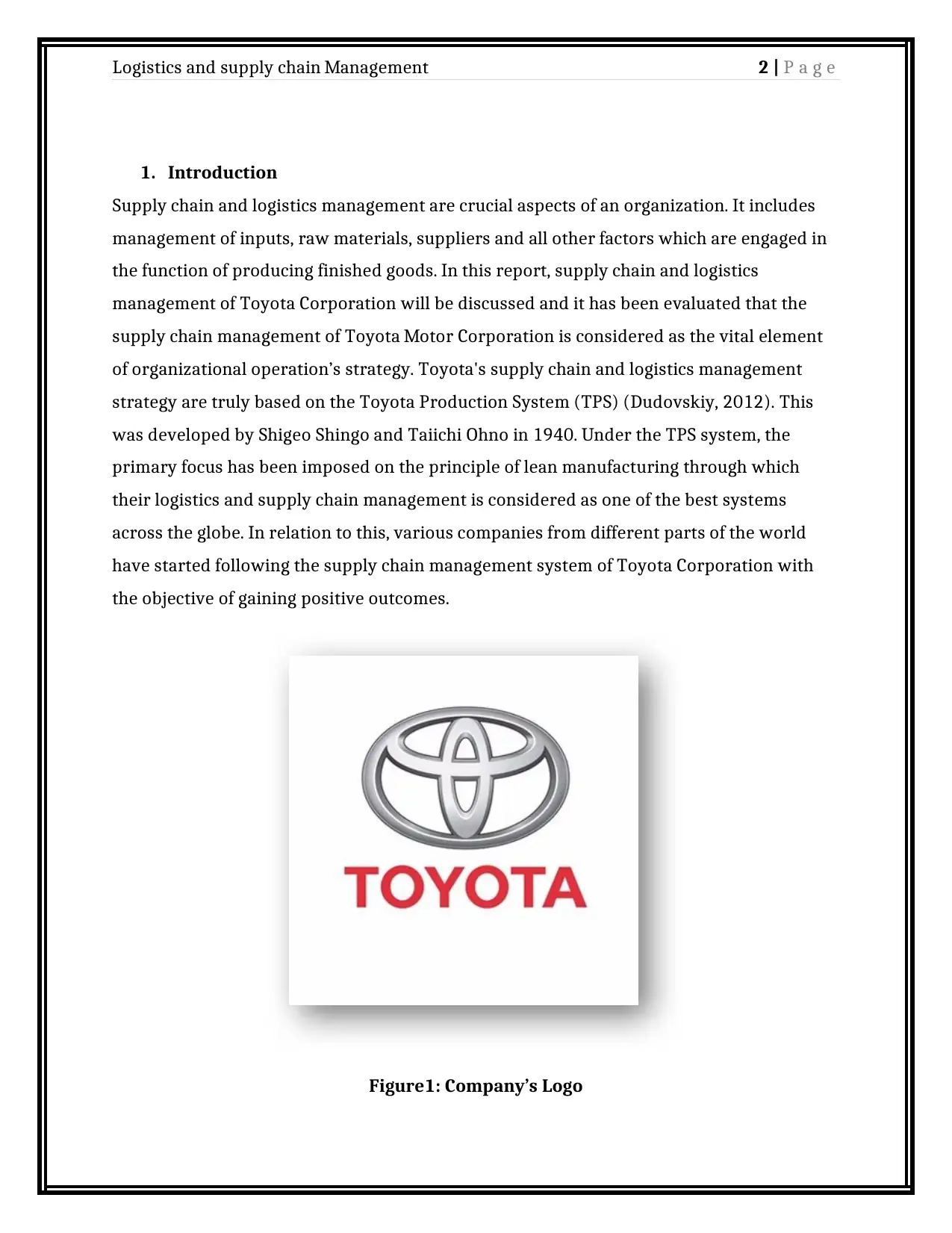
Logistics and supply chain Management 2 | P a g e
1. Introduction
Supply chain and logistics management are crucial aspects of an organization. It includes
management of inputs, raw materials, suppliers and all other factors which are engaged in
the function of producing finished goods. In this report, supply chain and logistics
management of Toyota Corporation will be discussed and it has been evaluated that the
supply chain management of Toyota Motor Corporation is considered as the vital element
of organizational operation’s strategy. Toyota's supply chain and logistics management
strategy are truly based on the Toyota Production System (TPS) (Dudovskiy, 2012). This
was developed by Shigeo Shingo and Taiichi Ohno in 1940. Under the TPS system, the
primary focus has been imposed on the principle of lean manufacturing through which
their logistics and supply chain management is considered as one of the best systems
across the globe. In relation to this, various companies from different parts of the world
have started following the supply chain management system of Toyota Corporation with
the objective of gaining positive outcomes.
Figure1: Company’s Logo
1. Introduction
Supply chain and logistics management are crucial aspects of an organization. It includes
management of inputs, raw materials, suppliers and all other factors which are engaged in
the function of producing finished goods. In this report, supply chain and logistics
management of Toyota Corporation will be discussed and it has been evaluated that the
supply chain management of Toyota Motor Corporation is considered as the vital element
of organizational operation’s strategy. Toyota's supply chain and logistics management
strategy are truly based on the Toyota Production System (TPS) (Dudovskiy, 2012). This
was developed by Shigeo Shingo and Taiichi Ohno in 1940. Under the TPS system, the
primary focus has been imposed on the principle of lean manufacturing through which
their logistics and supply chain management is considered as one of the best systems
across the globe. In relation to this, various companies from different parts of the world
have started following the supply chain management system of Toyota Corporation with
the objective of gaining positive outcomes.
Figure1: Company’s Logo
⊘ This is a preview!⊘
Do you want full access?
Subscribe today to unlock all pages.

Trusted by 1+ million students worldwide
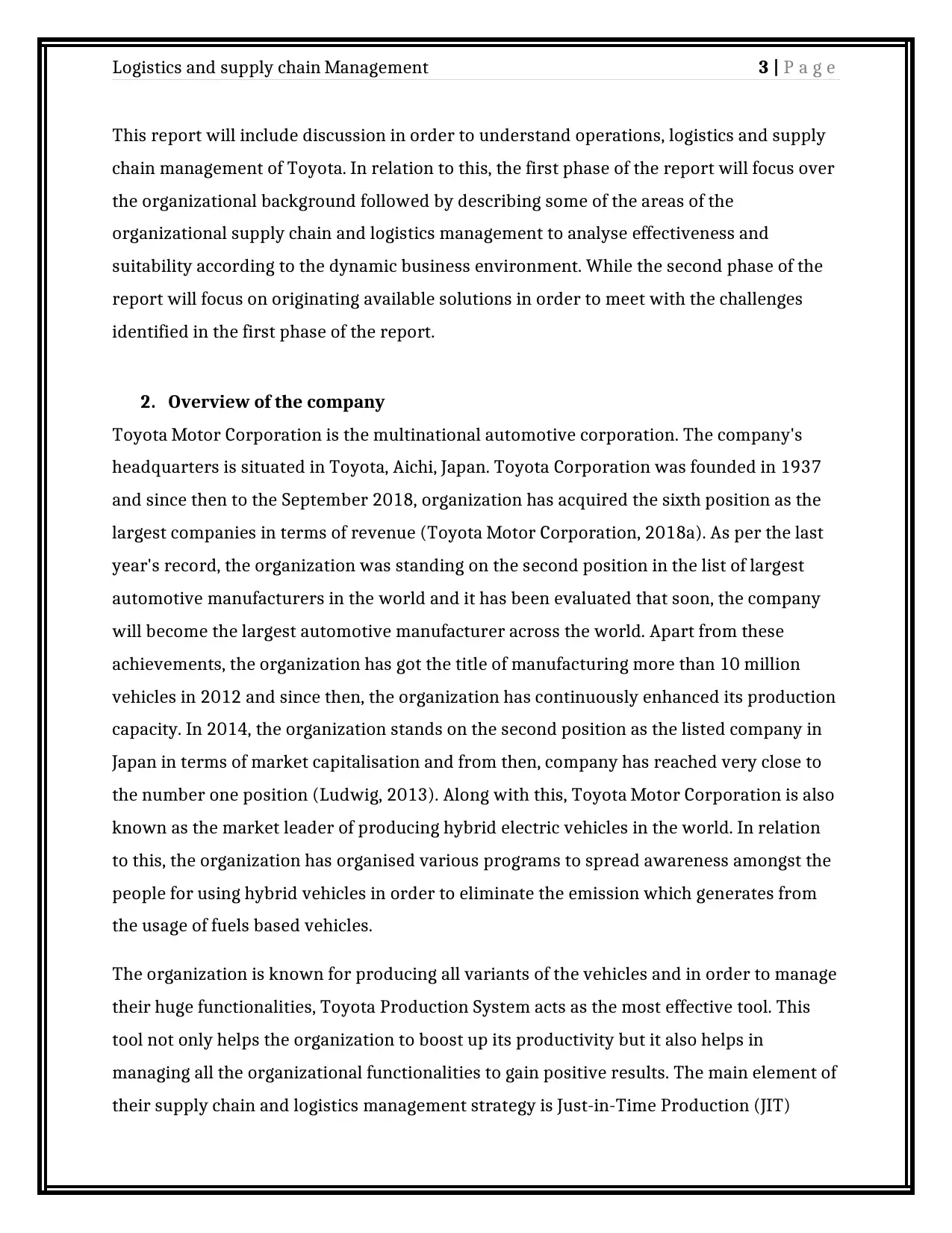
Logistics and supply chain Management 3 | P a g e
This report will include discussion in order to understand operations, logistics and supply
chain management of Toyota. In relation to this, the first phase of the report will focus over
the organizational background followed by describing some of the areas of the
organizational supply chain and logistics management to analyse effectiveness and
suitability according to the dynamic business environment. While the second phase of the
report will focus on originating available solutions in order to meet with the challenges
identified in the first phase of the report.
2. Overview of the company
Toyota Motor Corporation is the multinational automotive corporation. The company's
headquarters is situated in Toyota, Aichi, Japan. Toyota Corporation was founded in 1937
and since then to the September 2018, organization has acquired the sixth position as the
largest companies in terms of revenue (Toyota Motor Corporation, 2018a). As per the last
year's record, the organization was standing on the second position in the list of largest
automotive manufacturers in the world and it has been evaluated that soon, the company
will become the largest automotive manufacturer across the world. Apart from these
achievements, the organization has got the title of manufacturing more than 10 million
vehicles in 2012 and since then, the organization has continuously enhanced its production
capacity. In 2014, the organization stands on the second position as the listed company in
Japan in terms of market capitalisation and from then, company has reached very close to
the number one position (Ludwig, 2013). Along with this, Toyota Motor Corporation is also
known as the market leader of producing hybrid electric vehicles in the world. In relation
to this, the organization has organised various programs to spread awareness amongst the
people for using hybrid vehicles in order to eliminate the emission which generates from
the usage of fuels based vehicles.
The organization is known for producing all variants of the vehicles and in order to manage
their huge functionalities, Toyota Production System acts as the most effective tool. This
tool not only helps the organization to boost up its productivity but it also helps in
managing all the organizational functionalities to gain positive results. The main element of
their supply chain and logistics management strategy is Just-in-Time Production (JIT)
This report will include discussion in order to understand operations, logistics and supply
chain management of Toyota. In relation to this, the first phase of the report will focus over
the organizational background followed by describing some of the areas of the
organizational supply chain and logistics management to analyse effectiveness and
suitability according to the dynamic business environment. While the second phase of the
report will focus on originating available solutions in order to meet with the challenges
identified in the first phase of the report.
2. Overview of the company
Toyota Motor Corporation is the multinational automotive corporation. The company's
headquarters is situated in Toyota, Aichi, Japan. Toyota Corporation was founded in 1937
and since then to the September 2018, organization has acquired the sixth position as the
largest companies in terms of revenue (Toyota Motor Corporation, 2018a). As per the last
year's record, the organization was standing on the second position in the list of largest
automotive manufacturers in the world and it has been evaluated that soon, the company
will become the largest automotive manufacturer across the world. Apart from these
achievements, the organization has got the title of manufacturing more than 10 million
vehicles in 2012 and since then, the organization has continuously enhanced its production
capacity. In 2014, the organization stands on the second position as the listed company in
Japan in terms of market capitalisation and from then, company has reached very close to
the number one position (Ludwig, 2013). Along with this, Toyota Motor Corporation is also
known as the market leader of producing hybrid electric vehicles in the world. In relation
to this, the organization has organised various programs to spread awareness amongst the
people for using hybrid vehicles in order to eliminate the emission which generates from
the usage of fuels based vehicles.
The organization is known for producing all variants of the vehicles and in order to manage
their huge functionalities, Toyota Production System acts as the most effective tool. This
tool not only helps the organization to boost up its productivity but it also helps in
managing all the organizational functionalities to gain positive results. The main element of
their supply chain and logistics management strategy is Just-in-Time Production (JIT)
Paraphrase This Document
Need a fresh take? Get an instant paraphrase of this document with our AI Paraphraser
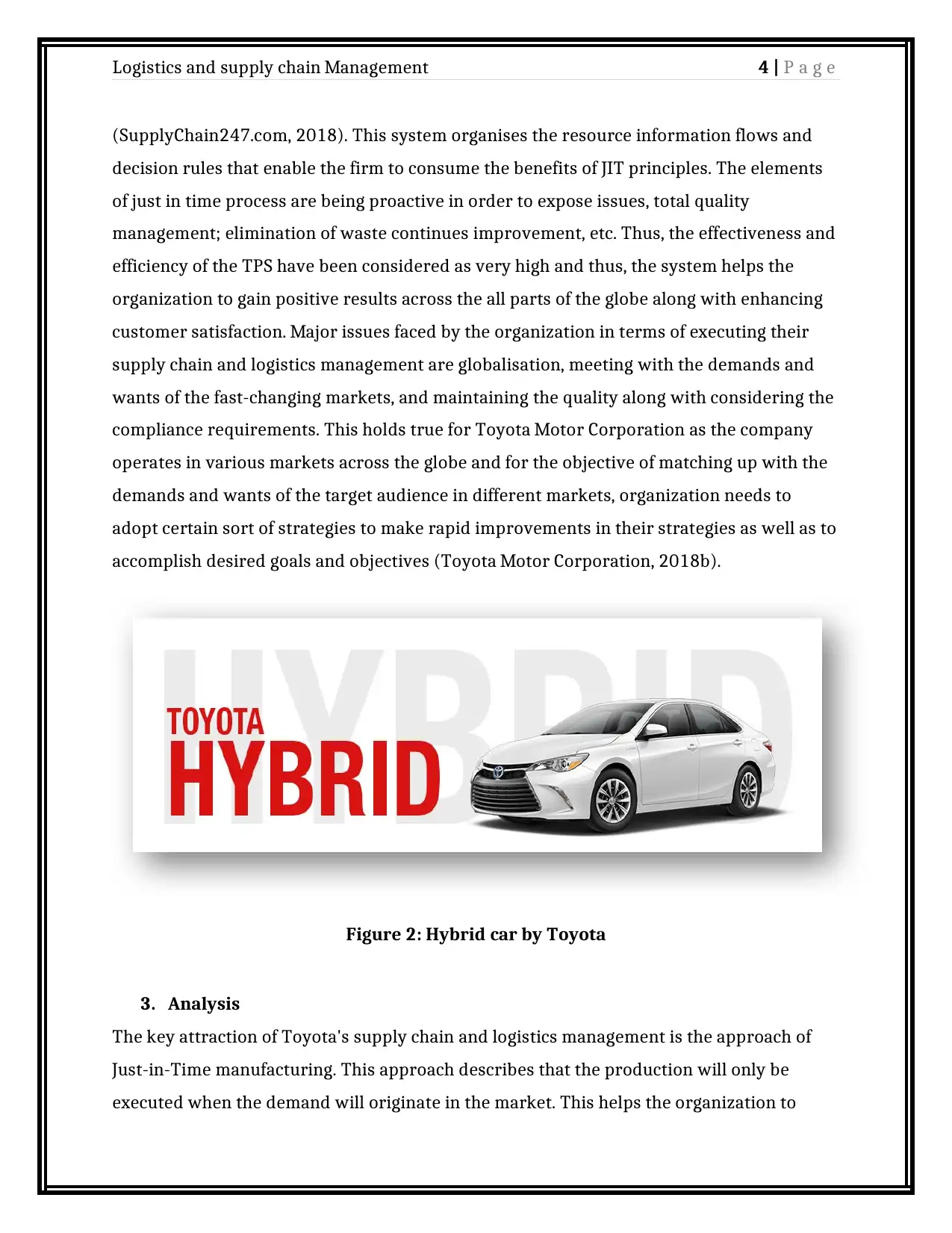
Logistics and supply chain Management 4 | P a g e
(SupplyChain247.com, 2018). This system organises the resource information flows and
decision rules that enable the firm to consume the benefits of JIT principles. The elements
of just in time process are being proactive in order to expose issues, total quality
management; elimination of waste continues improvement, etc. Thus, the effectiveness and
efficiency of the TPS have been considered as very high and thus, the system helps the
organization to gain positive results across the all parts of the globe along with enhancing
customer satisfaction. Major issues faced by the organization in terms of executing their
supply chain and logistics management are globalisation, meeting with the demands and
wants of the fast-changing markets, and maintaining the quality along with considering the
compliance requirements. This holds true for Toyota Motor Corporation as the company
operates in various markets across the globe and for the objective of matching up with the
demands and wants of the target audience in different markets, organization needs to
adopt certain sort of strategies to make rapid improvements in their strategies as well as to
accomplish desired goals and objectives (Toyota Motor Corporation, 2018b).
Figure 2: Hybrid car by Toyota
3. Analysis
The key attraction of Toyota's supply chain and logistics management is the approach of
Just-in-Time manufacturing. This approach describes that the production will only be
executed when the demand will originate in the market. This helps the organization to
(SupplyChain247.com, 2018). This system organises the resource information flows and
decision rules that enable the firm to consume the benefits of JIT principles. The elements
of just in time process are being proactive in order to expose issues, total quality
management; elimination of waste continues improvement, etc. Thus, the effectiveness and
efficiency of the TPS have been considered as very high and thus, the system helps the
organization to gain positive results across the all parts of the globe along with enhancing
customer satisfaction. Major issues faced by the organization in terms of executing their
supply chain and logistics management are globalisation, meeting with the demands and
wants of the fast-changing markets, and maintaining the quality along with considering the
compliance requirements. This holds true for Toyota Motor Corporation as the company
operates in various markets across the globe and for the objective of matching up with the
demands and wants of the target audience in different markets, organization needs to
adopt certain sort of strategies to make rapid improvements in their strategies as well as to
accomplish desired goals and objectives (Toyota Motor Corporation, 2018b).
Figure 2: Hybrid car by Toyota
3. Analysis
The key attraction of Toyota's supply chain and logistics management is the approach of
Just-in-Time manufacturing. This approach describes that the production will only be
executed when the demand will originate in the market. This helps the organization to
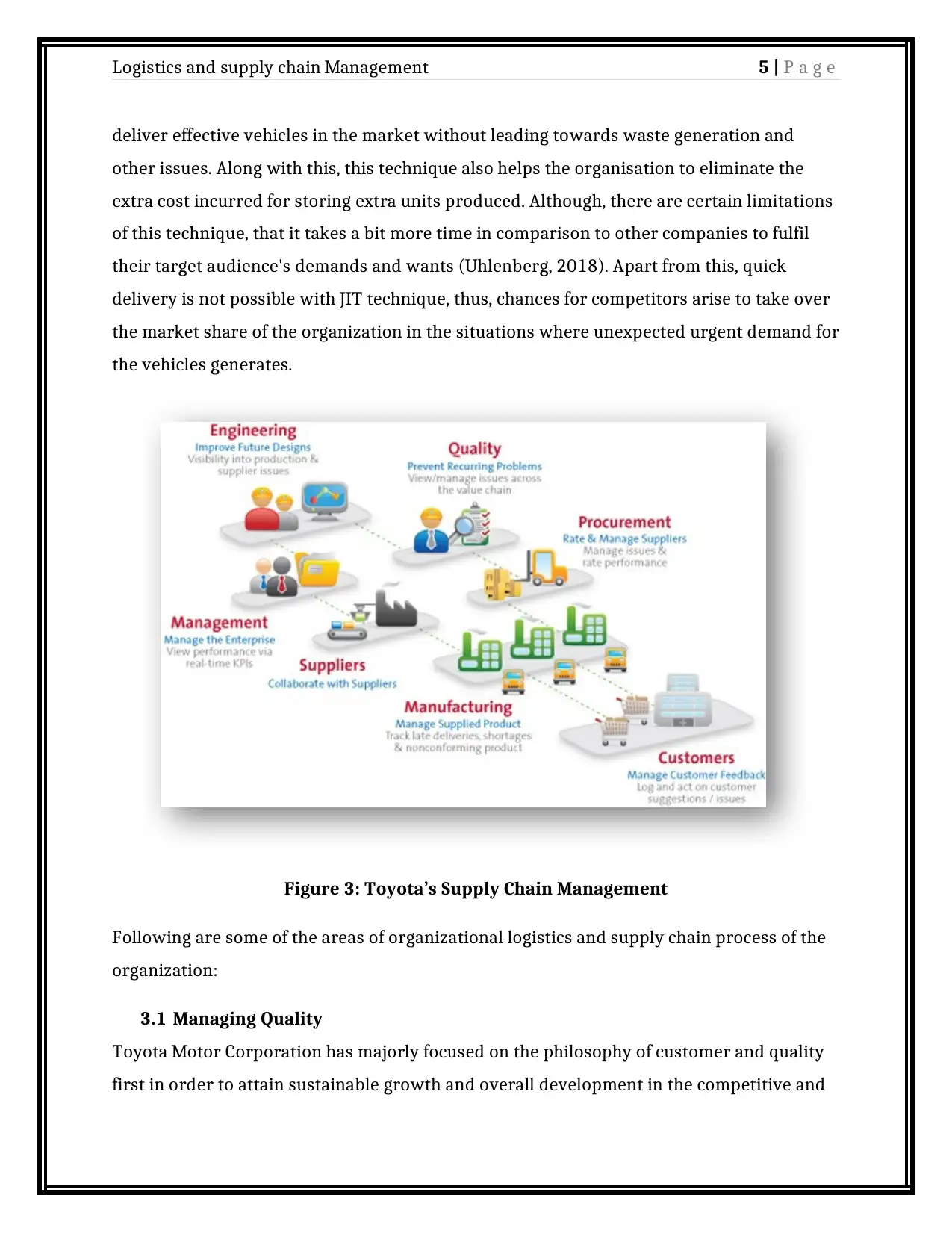
Logistics and supply chain Management 5 | P a g e
deliver effective vehicles in the market without leading towards waste generation and
other issues. Along with this, this technique also helps the organisation to eliminate the
extra cost incurred for storing extra units produced. Although, there are certain limitations
of this technique, that it takes a bit more time in comparison to other companies to fulfil
their target audience's demands and wants (Uhlenberg, 2018). Apart from this, quick
delivery is not possible with JIT technique, thus, chances for competitors arise to take over
the market share of the organization in the situations where unexpected urgent demand for
the vehicles generates.
Figure 3: Toyota’s Supply Chain Management
Following are some of the areas of organizational logistics and supply chain process of the
organization:
3.1 Managing Quality
Toyota Motor Corporation has majorly focused on the philosophy of customer and quality
first in order to attain sustainable growth and overall development in the competitive and
deliver effective vehicles in the market without leading towards waste generation and
other issues. Along with this, this technique also helps the organisation to eliminate the
extra cost incurred for storing extra units produced. Although, there are certain limitations
of this technique, that it takes a bit more time in comparison to other companies to fulfil
their target audience's demands and wants (Uhlenberg, 2018). Apart from this, quick
delivery is not possible with JIT technique, thus, chances for competitors arise to take over
the market share of the organization in the situations where unexpected urgent demand for
the vehicles generates.
Figure 3: Toyota’s Supply Chain Management
Following are some of the areas of organizational logistics and supply chain process of the
organization:
3.1 Managing Quality
Toyota Motor Corporation has majorly focused on the philosophy of customer and quality
first in order to attain sustainable growth and overall development in the competitive and
⊘ This is a preview!⊘
Do you want full access?
Subscribe today to unlock all pages.

Trusted by 1+ million students worldwide
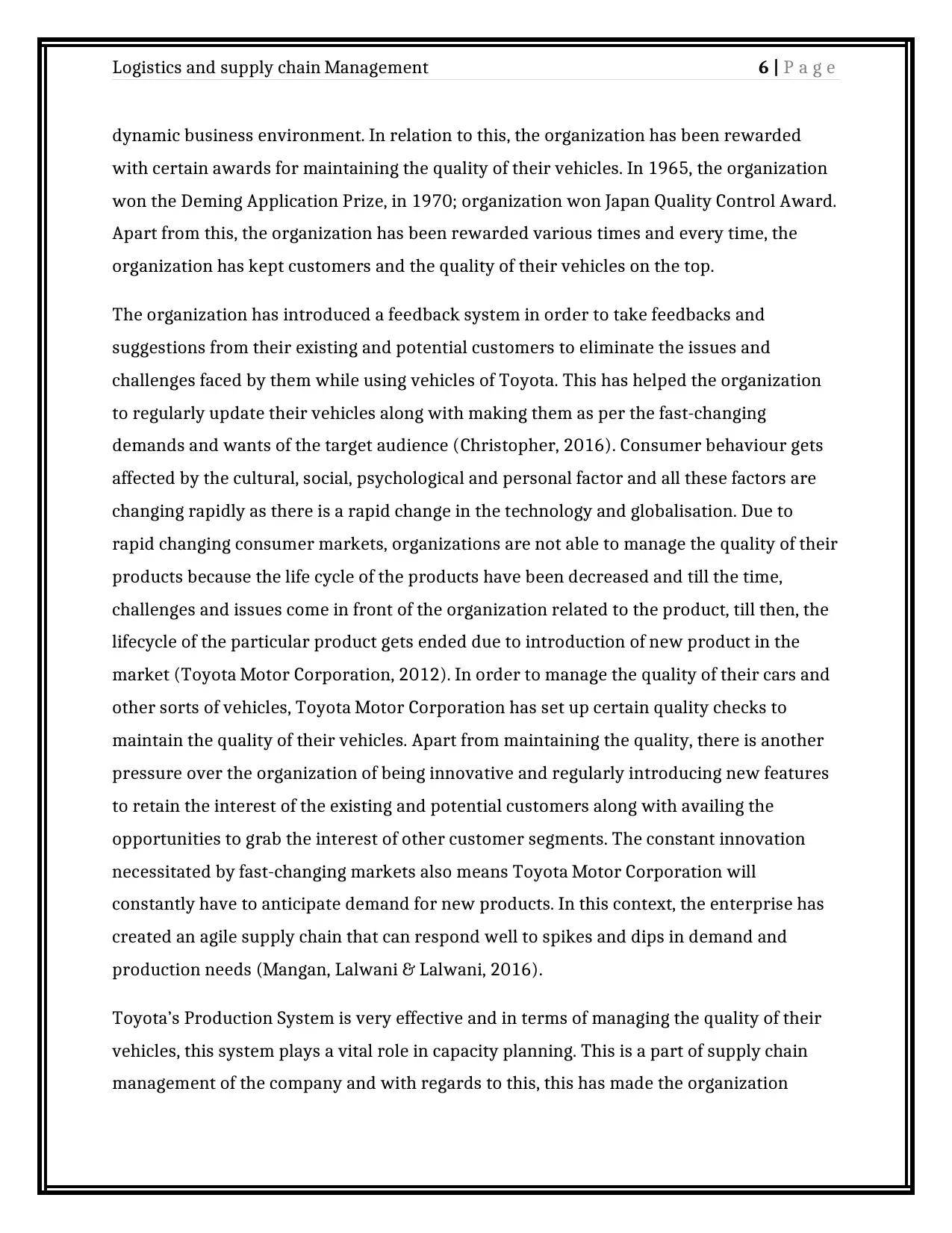
Logistics and supply chain Management 6 | P a g e
dynamic business environment. In relation to this, the organization has been rewarded
with certain awards for maintaining the quality of their vehicles. In 1965, the organization
won the Deming Application Prize, in 1970; organization won Japan Quality Control Award.
Apart from this, the organization has been rewarded various times and every time, the
organization has kept customers and the quality of their vehicles on the top.
The organization has introduced a feedback system in order to take feedbacks and
suggestions from their existing and potential customers to eliminate the issues and
challenges faced by them while using vehicles of Toyota. This has helped the organization
to regularly update their vehicles along with making them as per the fast-changing
demands and wants of the target audience (Christopher, 2016). Consumer behaviour gets
affected by the cultural, social, psychological and personal factor and all these factors are
changing rapidly as there is a rapid change in the technology and globalisation. Due to
rapid changing consumer markets, organizations are not able to manage the quality of their
products because the life cycle of the products have been decreased and till the time,
challenges and issues come in front of the organization related to the product, till then, the
lifecycle of the particular product gets ended due to introduction of new product in the
market (Toyota Motor Corporation, 2012). In order to manage the quality of their cars and
other sorts of vehicles, Toyota Motor Corporation has set up certain quality checks to
maintain the quality of their vehicles. Apart from maintaining the quality, there is another
pressure over the organization of being innovative and regularly introducing new features
to retain the interest of the existing and potential customers along with availing the
opportunities to grab the interest of other customer segments. The constant innovation
necessitated by fast-changing markets also means Toyota Motor Corporation will
constantly have to anticipate demand for new products. In this context, the enterprise has
created an agile supply chain that can respond well to spikes and dips in demand and
production needs (Mangan, Lalwani & Lalwani, 2016).
Toyota’s Production System is very effective and in terms of managing the quality of their
vehicles, this system plays a vital role in capacity planning. This is a part of supply chain
management of the company and with regards to this, this has made the organization
dynamic business environment. In relation to this, the organization has been rewarded
with certain awards for maintaining the quality of their vehicles. In 1965, the organization
won the Deming Application Prize, in 1970; organization won Japan Quality Control Award.
Apart from this, the organization has been rewarded various times and every time, the
organization has kept customers and the quality of their vehicles on the top.
The organization has introduced a feedback system in order to take feedbacks and
suggestions from their existing and potential customers to eliminate the issues and
challenges faced by them while using vehicles of Toyota. This has helped the organization
to regularly update their vehicles along with making them as per the fast-changing
demands and wants of the target audience (Christopher, 2016). Consumer behaviour gets
affected by the cultural, social, psychological and personal factor and all these factors are
changing rapidly as there is a rapid change in the technology and globalisation. Due to
rapid changing consumer markets, organizations are not able to manage the quality of their
products because the life cycle of the products have been decreased and till the time,
challenges and issues come in front of the organization related to the product, till then, the
lifecycle of the particular product gets ended due to introduction of new product in the
market (Toyota Motor Corporation, 2012). In order to manage the quality of their cars and
other sorts of vehicles, Toyota Motor Corporation has set up certain quality checks to
maintain the quality of their vehicles. Apart from maintaining the quality, there is another
pressure over the organization of being innovative and regularly introducing new features
to retain the interest of the existing and potential customers along with availing the
opportunities to grab the interest of other customer segments. The constant innovation
necessitated by fast-changing markets also means Toyota Motor Corporation will
constantly have to anticipate demand for new products. In this context, the enterprise has
created an agile supply chain that can respond well to spikes and dips in demand and
production needs (Mangan, Lalwani & Lalwani, 2016).
Toyota’s Production System is very effective and in terms of managing the quality of their
vehicles, this system plays a vital role in capacity planning. This is a part of supply chain
management of the company and with regards to this, this has made the organization
Paraphrase This Document
Need a fresh take? Get an instant paraphrase of this document with our AI Paraphraser
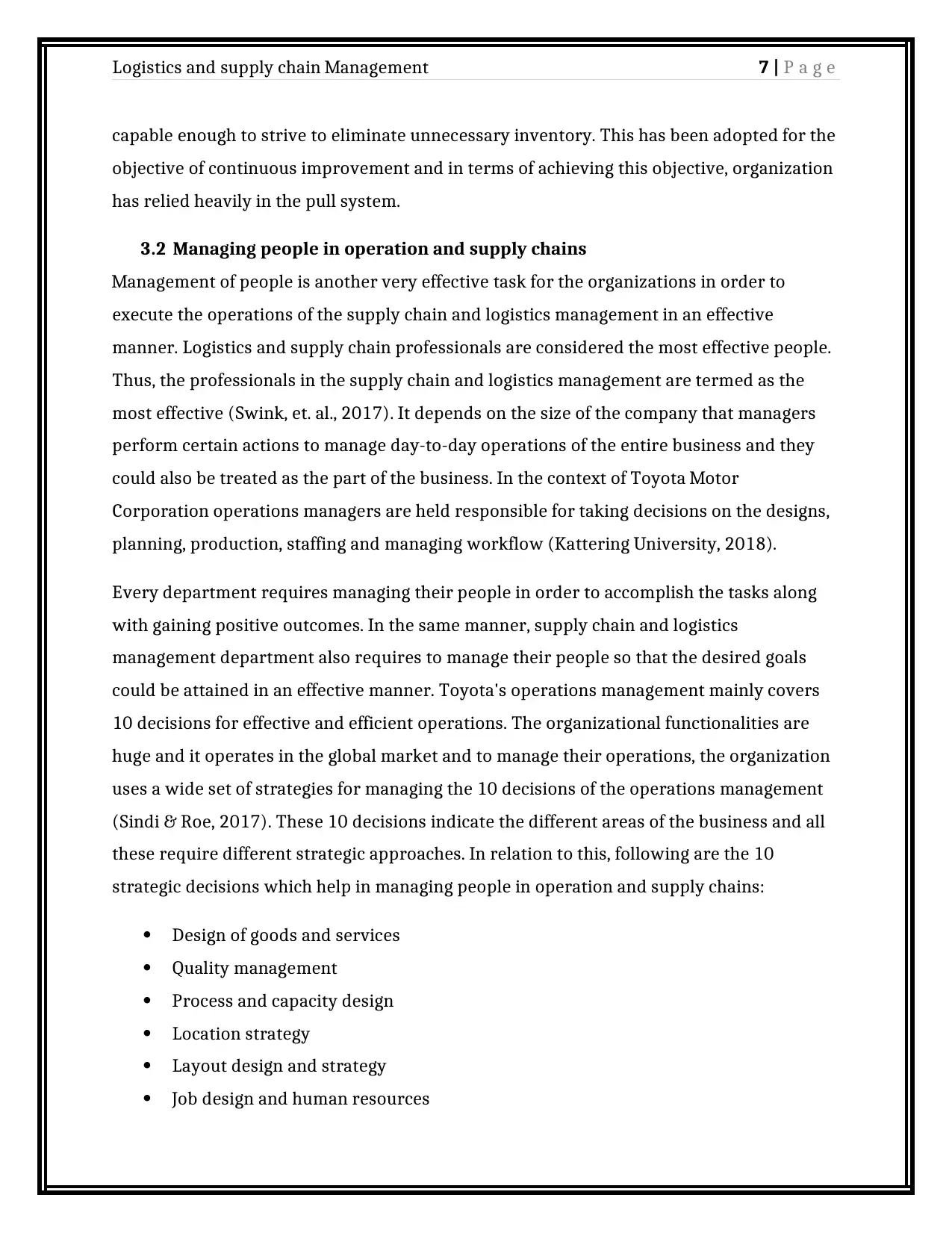
Logistics and supply chain Management 7 | P a g e
capable enough to strive to eliminate unnecessary inventory. This has been adopted for the
objective of continuous improvement and in terms of achieving this objective, organization
has relied heavily in the pull system.
3.2 Managing people in operation and supply chains
Management of people is another very effective task for the organizations in order to
execute the operations of the supply chain and logistics management in an effective
manner. Logistics and supply chain professionals are considered the most effective people.
Thus, the professionals in the supply chain and logistics management are termed as the
most effective (Swink, et. al., 2017). It depends on the size of the company that managers
perform certain actions to manage day-to-day operations of the entire business and they
could also be treated as the part of the business. In the context of Toyota Motor
Corporation operations managers are held responsible for taking decisions on the designs,
planning, production, staffing and managing workflow (Kattering University, 2018).
Every department requires managing their people in order to accomplish the tasks along
with gaining positive outcomes. In the same manner, supply chain and logistics
management department also requires to manage their people so that the desired goals
could be attained in an effective manner. Toyota's operations management mainly covers
10 decisions for effective and efficient operations. The organizational functionalities are
huge and it operates in the global market and to manage their operations, the organization
uses a wide set of strategies for managing the 10 decisions of the operations management
(Sindi & Roe, 2017). These 10 decisions indicate the different areas of the business and all
these require different strategic approaches. In relation to this, following are the 10
strategic decisions which help in managing people in operation and supply chains:
Design of goods and services
Quality management
Process and capacity design
Location strategy
Layout design and strategy
Job design and human resources
capable enough to strive to eliminate unnecessary inventory. This has been adopted for the
objective of continuous improvement and in terms of achieving this objective, organization
has relied heavily in the pull system.
3.2 Managing people in operation and supply chains
Management of people is another very effective task for the organizations in order to
execute the operations of the supply chain and logistics management in an effective
manner. Logistics and supply chain professionals are considered the most effective people.
Thus, the professionals in the supply chain and logistics management are termed as the
most effective (Swink, et. al., 2017). It depends on the size of the company that managers
perform certain actions to manage day-to-day operations of the entire business and they
could also be treated as the part of the business. In the context of Toyota Motor
Corporation operations managers are held responsible for taking decisions on the designs,
planning, production, staffing and managing workflow (Kattering University, 2018).
Every department requires managing their people in order to accomplish the tasks along
with gaining positive outcomes. In the same manner, supply chain and logistics
management department also requires to manage their people so that the desired goals
could be attained in an effective manner. Toyota's operations management mainly covers
10 decisions for effective and efficient operations. The organizational functionalities are
huge and it operates in the global market and to manage their operations, the organization
uses a wide set of strategies for managing the 10 decisions of the operations management
(Sindi & Roe, 2017). These 10 decisions indicate the different areas of the business and all
these require different strategic approaches. In relation to this, following are the 10
strategic decisions which help in managing people in operation and supply chains:
Design of goods and services
Quality management
Process and capacity design
Location strategy
Layout design and strategy
Job design and human resources
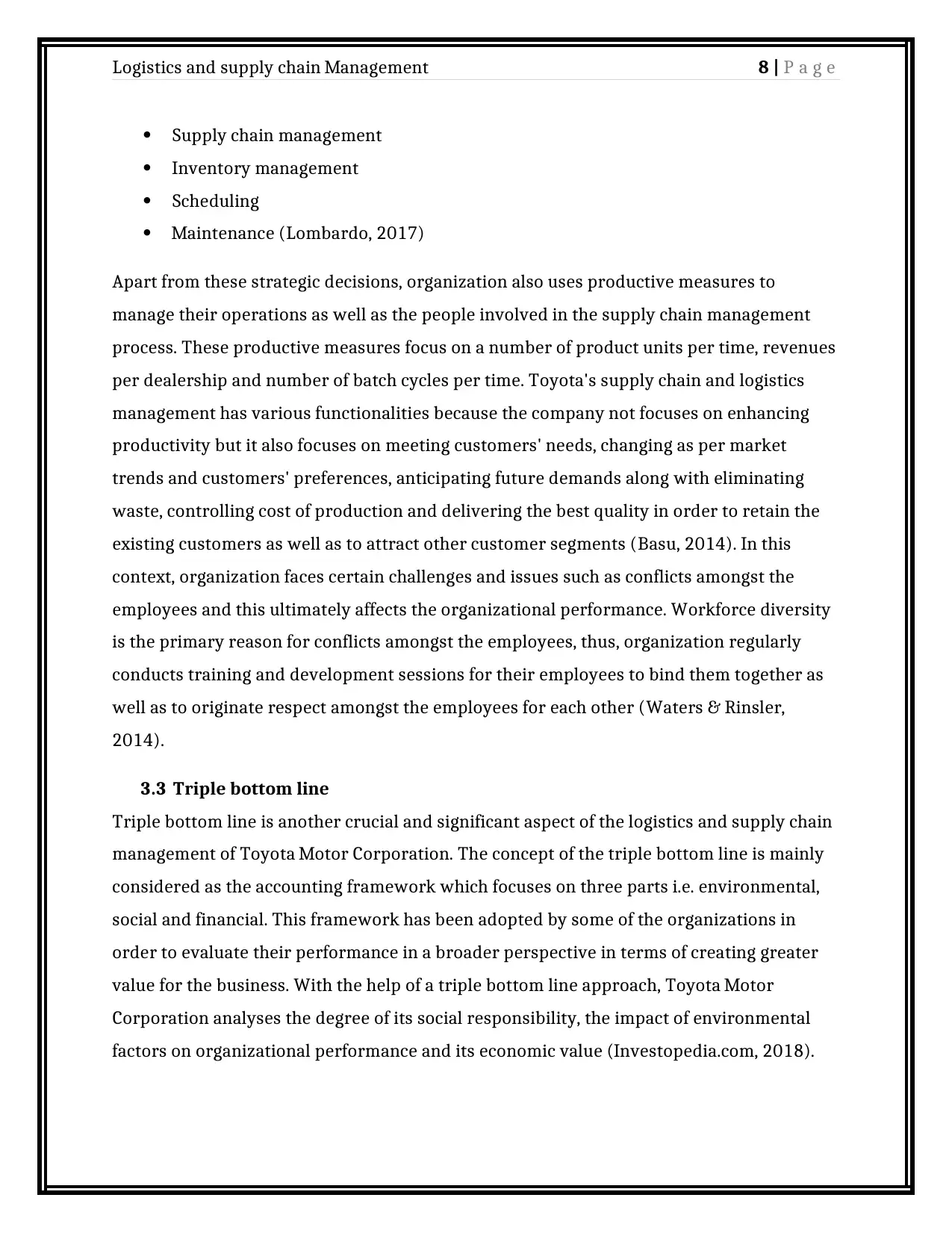
Logistics and supply chain Management 8 | P a g e
Supply chain management
Inventory management
Scheduling
Maintenance (Lombardo, 2017)
Apart from these strategic decisions, organization also uses productive measures to
manage their operations as well as the people involved in the supply chain management
process. These productive measures focus on a number of product units per time, revenues
per dealership and number of batch cycles per time. Toyota's supply chain and logistics
management has various functionalities because the company not focuses on enhancing
productivity but it also focuses on meeting customers' needs, changing as per market
trends and customers' preferences, anticipating future demands along with eliminating
waste, controlling cost of production and delivering the best quality in order to retain the
existing customers as well as to attract other customer segments (Basu, 2014). In this
context, organization faces certain challenges and issues such as conflicts amongst the
employees and this ultimately affects the organizational performance. Workforce diversity
is the primary reason for conflicts amongst the employees, thus, organization regularly
conducts training and development sessions for their employees to bind them together as
well as to originate respect amongst the employees for each other (Waters & Rinsler,
2014).
3.3 Triple bottom line
Triple bottom line is another crucial and significant aspect of the logistics and supply chain
management of Toyota Motor Corporation. The concept of the triple bottom line is mainly
considered as the accounting framework which focuses on three parts i.e. environmental,
social and financial. This framework has been adopted by some of the organizations in
order to evaluate their performance in a broader perspective in terms of creating greater
value for the business. With the help of a triple bottom line approach, Toyota Motor
Corporation analyses the degree of its social responsibility, the impact of environmental
factors on organizational performance and its economic value (Investopedia.com, 2018).
Supply chain management
Inventory management
Scheduling
Maintenance (Lombardo, 2017)
Apart from these strategic decisions, organization also uses productive measures to
manage their operations as well as the people involved in the supply chain management
process. These productive measures focus on a number of product units per time, revenues
per dealership and number of batch cycles per time. Toyota's supply chain and logistics
management has various functionalities because the company not focuses on enhancing
productivity but it also focuses on meeting customers' needs, changing as per market
trends and customers' preferences, anticipating future demands along with eliminating
waste, controlling cost of production and delivering the best quality in order to retain the
existing customers as well as to attract other customer segments (Basu, 2014). In this
context, organization faces certain challenges and issues such as conflicts amongst the
employees and this ultimately affects the organizational performance. Workforce diversity
is the primary reason for conflicts amongst the employees, thus, organization regularly
conducts training and development sessions for their employees to bind them together as
well as to originate respect amongst the employees for each other (Waters & Rinsler,
2014).
3.3 Triple bottom line
Triple bottom line is another crucial and significant aspect of the logistics and supply chain
management of Toyota Motor Corporation. The concept of the triple bottom line is mainly
considered as the accounting framework which focuses on three parts i.e. environmental,
social and financial. This framework has been adopted by some of the organizations in
order to evaluate their performance in a broader perspective in terms of creating greater
value for the business. With the help of a triple bottom line approach, Toyota Motor
Corporation analyses the degree of its social responsibility, the impact of environmental
factors on organizational performance and its economic value (Investopedia.com, 2018).
⊘ This is a preview!⊘
Do you want full access?
Subscribe today to unlock all pages.

Trusted by 1+ million students worldwide
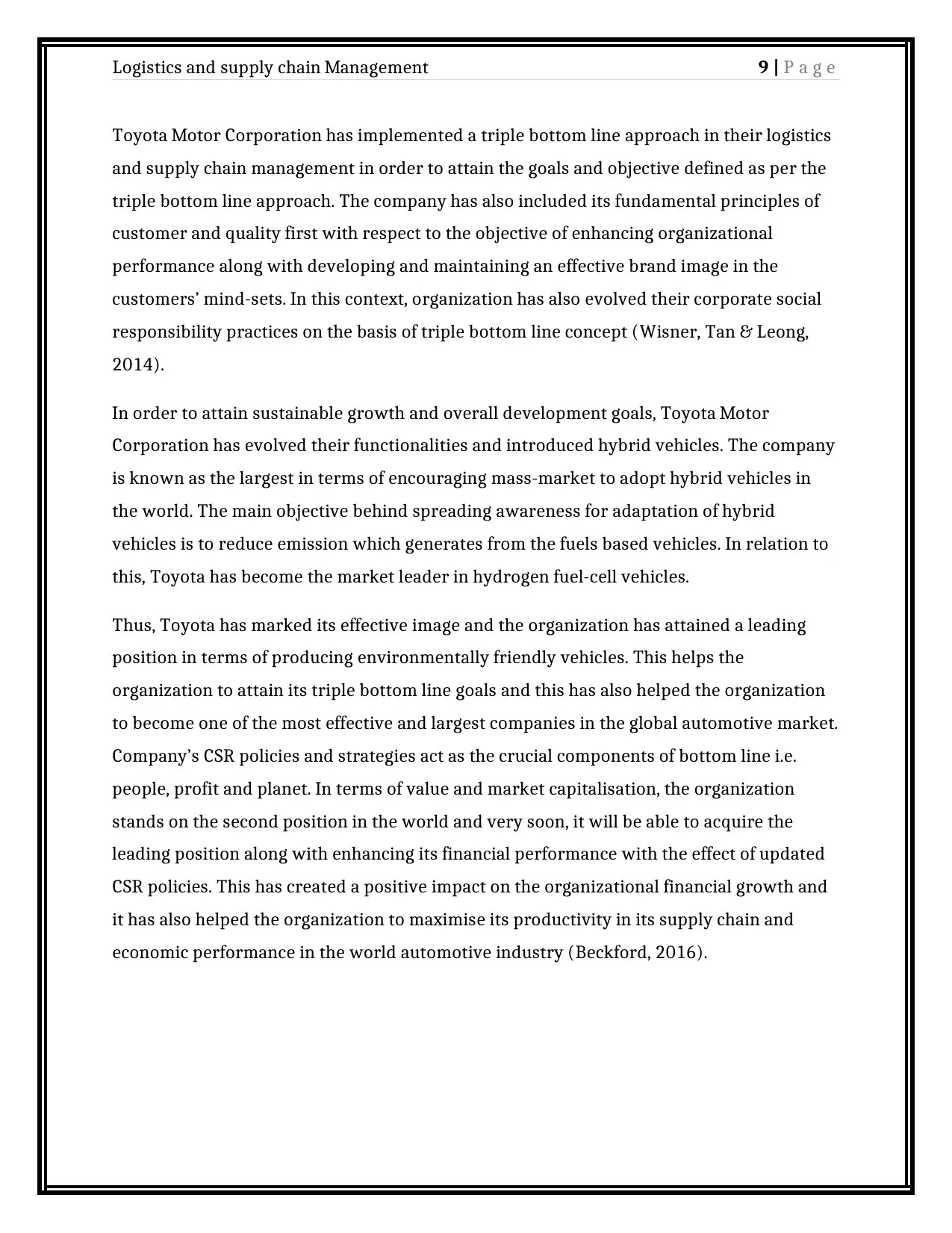
Logistics and supply chain Management 9 | P a g e
Toyota Motor Corporation has implemented a triple bottom line approach in their logistics
and supply chain management in order to attain the goals and objective defined as per the
triple bottom line approach. The company has also included its fundamental principles of
customer and quality first with respect to the objective of enhancing organizational
performance along with developing and maintaining an effective brand image in the
customers’ mind-sets. In this context, organization has also evolved their corporate social
responsibility practices on the basis of triple bottom line concept (Wisner, Tan & Leong,
2014).
In order to attain sustainable growth and overall development goals, Toyota Motor
Corporation has evolved their functionalities and introduced hybrid vehicles. The company
is known as the largest in terms of encouraging mass-market to adopt hybrid vehicles in
the world. The main objective behind spreading awareness for adaptation of hybrid
vehicles is to reduce emission which generates from the fuels based vehicles. In relation to
this, Toyota has become the market leader in hydrogen fuel-cell vehicles.
Thus, Toyota has marked its effective image and the organization has attained a leading
position in terms of producing environmentally friendly vehicles. This helps the
organization to attain its triple bottom line goals and this has also helped the organization
to become one of the most effective and largest companies in the global automotive market.
Company’s CSR policies and strategies act as the crucial components of bottom line i.e.
people, profit and planet. In terms of value and market capitalisation, the organization
stands on the second position in the world and very soon, it will be able to acquire the
leading position along with enhancing its financial performance with the effect of updated
CSR policies. This has created a positive impact on the organizational financial growth and
it has also helped the organization to maximise its productivity in its supply chain and
economic performance in the world automotive industry (Beckford, 2016).
Toyota Motor Corporation has implemented a triple bottom line approach in their logistics
and supply chain management in order to attain the goals and objective defined as per the
triple bottom line approach. The company has also included its fundamental principles of
customer and quality first with respect to the objective of enhancing organizational
performance along with developing and maintaining an effective brand image in the
customers’ mind-sets. In this context, organization has also evolved their corporate social
responsibility practices on the basis of triple bottom line concept (Wisner, Tan & Leong,
2014).
In order to attain sustainable growth and overall development goals, Toyota Motor
Corporation has evolved their functionalities and introduced hybrid vehicles. The company
is known as the largest in terms of encouraging mass-market to adopt hybrid vehicles in
the world. The main objective behind spreading awareness for adaptation of hybrid
vehicles is to reduce emission which generates from the fuels based vehicles. In relation to
this, Toyota has become the market leader in hydrogen fuel-cell vehicles.
Thus, Toyota has marked its effective image and the organization has attained a leading
position in terms of producing environmentally friendly vehicles. This helps the
organization to attain its triple bottom line goals and this has also helped the organization
to become one of the most effective and largest companies in the global automotive market.
Company’s CSR policies and strategies act as the crucial components of bottom line i.e.
people, profit and planet. In terms of value and market capitalisation, the organization
stands on the second position in the world and very soon, it will be able to acquire the
leading position along with enhancing its financial performance with the effect of updated
CSR policies. This has created a positive impact on the organizational financial growth and
it has also helped the organization to maximise its productivity in its supply chain and
economic performance in the world automotive industry (Beckford, 2016).
Paraphrase This Document
Need a fresh take? Get an instant paraphrase of this document with our AI Paraphraser
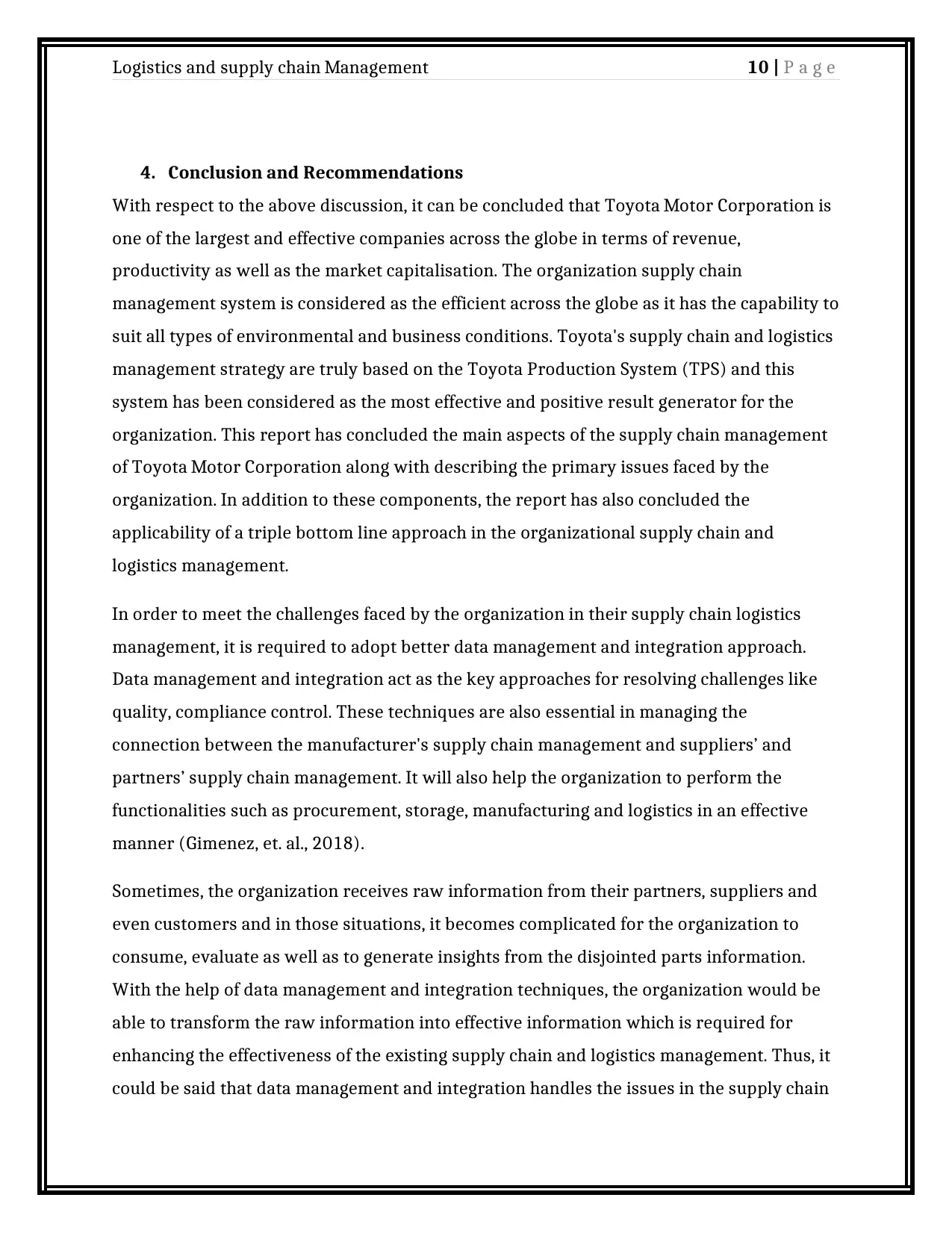
Logistics and supply chain Management 10 | P a g e
4. Conclusion and Recommendations
With respect to the above discussion, it can be concluded that Toyota Motor Corporation is
one of the largest and effective companies across the globe in terms of revenue,
productivity as well as the market capitalisation. The organization supply chain
management system is considered as the efficient across the globe as it has the capability to
suit all types of environmental and business conditions. Toyota's supply chain and logistics
management strategy are truly based on the Toyota Production System (TPS) and this
system has been considered as the most effective and positive result generator for the
organization. This report has concluded the main aspects of the supply chain management
of Toyota Motor Corporation along with describing the primary issues faced by the
organization. In addition to these components, the report has also concluded the
applicability of a triple bottom line approach in the organizational supply chain and
logistics management.
In order to meet the challenges faced by the organization in their supply chain logistics
management, it is required to adopt better data management and integration approach.
Data management and integration act as the key approaches for resolving challenges like
quality, compliance control. These techniques are also essential in managing the
connection between the manufacturer's supply chain management and suppliers’ and
partners’ supply chain management. It will also help the organization to perform the
functionalities such as procurement, storage, manufacturing and logistics in an effective
manner (Gimenez, et. al., 2018).
Sometimes, the organization receives raw information from their partners, suppliers and
even customers and in those situations, it becomes complicated for the organization to
consume, evaluate as well as to generate insights from the disjointed parts information.
With the help of data management and integration techniques, the organization would be
able to transform the raw information into effective information which is required for
enhancing the effectiveness of the existing supply chain and logistics management. Thus, it
could be said that data management and integration handles the issues in the supply chain
4. Conclusion and Recommendations
With respect to the above discussion, it can be concluded that Toyota Motor Corporation is
one of the largest and effective companies across the globe in terms of revenue,
productivity as well as the market capitalisation. The organization supply chain
management system is considered as the efficient across the globe as it has the capability to
suit all types of environmental and business conditions. Toyota's supply chain and logistics
management strategy are truly based on the Toyota Production System (TPS) and this
system has been considered as the most effective and positive result generator for the
organization. This report has concluded the main aspects of the supply chain management
of Toyota Motor Corporation along with describing the primary issues faced by the
organization. In addition to these components, the report has also concluded the
applicability of a triple bottom line approach in the organizational supply chain and
logistics management.
In order to meet the challenges faced by the organization in their supply chain logistics
management, it is required to adopt better data management and integration approach.
Data management and integration act as the key approaches for resolving challenges like
quality, compliance control. These techniques are also essential in managing the
connection between the manufacturer's supply chain management and suppliers’ and
partners’ supply chain management. It will also help the organization to perform the
functionalities such as procurement, storage, manufacturing and logistics in an effective
manner (Gimenez, et. al., 2018).
Sometimes, the organization receives raw information from their partners, suppliers and
even customers and in those situations, it becomes complicated for the organization to
consume, evaluate as well as to generate insights from the disjointed parts information.
With the help of data management and integration techniques, the organization would be
able to transform the raw information into effective information which is required for
enhancing the effectiveness of the existing supply chain and logistics management. Thus, it
could be said that data management and integration handles the issues in the supply chain
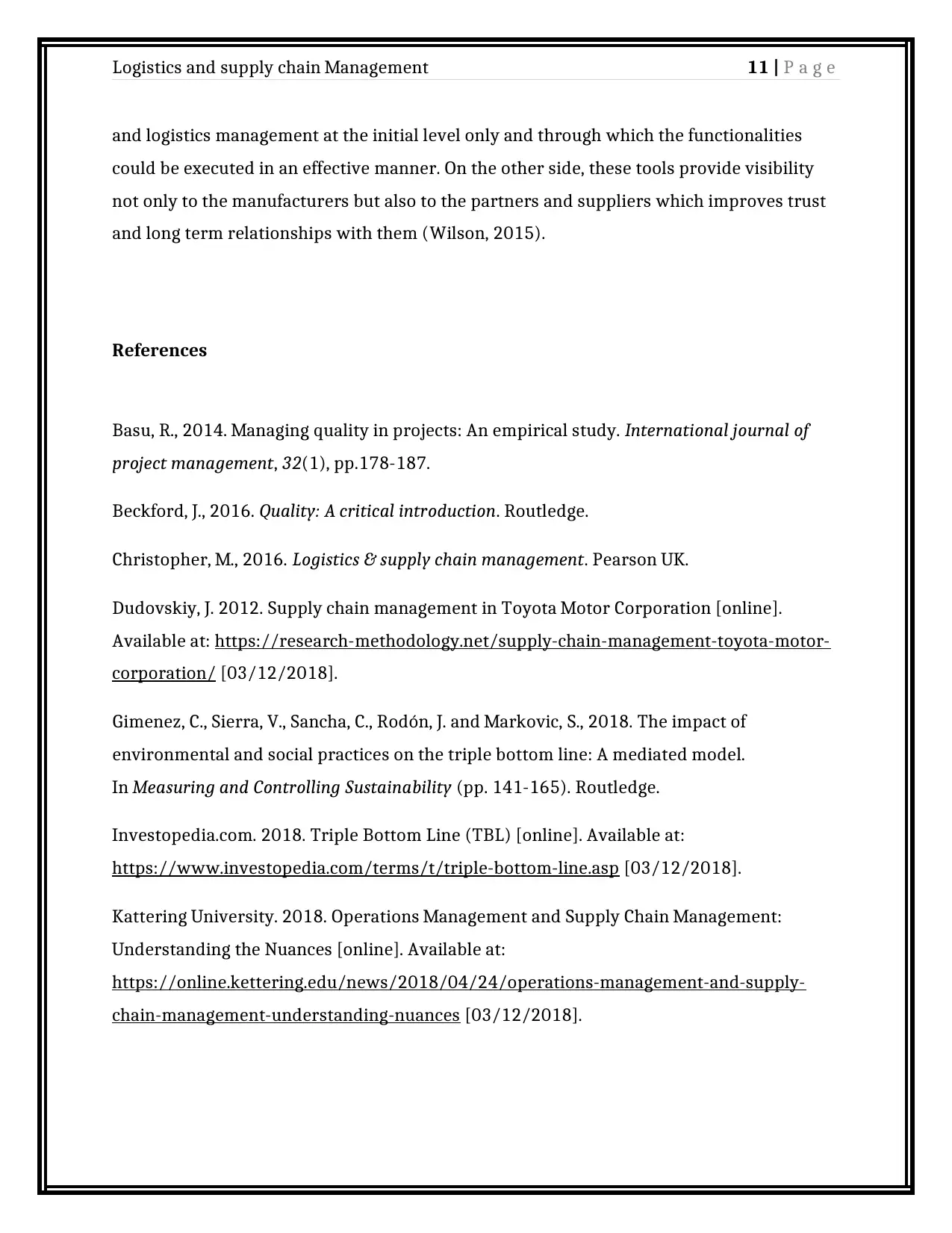
Logistics and supply chain Management 11 | P a g e
and logistics management at the initial level only and through which the functionalities
could be executed in an effective manner. On the other side, these tools provide visibility
not only to the manufacturers but also to the partners and suppliers which improves trust
and long term relationships with them (Wilson, 2015).
References
Basu, R., 2014. Managing quality in projects: An empirical study. International journal of
project management, 32(1), pp.178-187.
Beckford, J., 2016. Quality: A critical introduction. Routledge.
Christopher, M., 2016. Logistics & supply chain management. Pearson UK.
Dudovskiy, J. 2012. Supply chain management in Toyota Motor Corporation [online].
Available at: https://research-methodology.net/supply-chain-management-toyota-motor-
corporation/ [03/12/2018].
Gimenez, C., Sierra, V., Sancha, C., Rodón, J. and Markovic, S., 2018. The impact of
environmental and social practices on the triple bottom line: A mediated model.
In Measuring and Controlling Sustainability (pp. 141-165). Routledge.
Investopedia.com. 2018. Triple Bottom Line (TBL) [online]. Available at:
https://www.investopedia.com/terms/t/triple-bottom-line.asp [03/12/2018].
Kattering University. 2018. Operations Management and Supply Chain Management:
Understanding the Nuances [online]. Available at:
https://online.kettering.edu/news/2018/04/24/operations-management-and-supply-
chain-management-understanding-nuances [03/12/2018].
and logistics management at the initial level only and through which the functionalities
could be executed in an effective manner. On the other side, these tools provide visibility
not only to the manufacturers but also to the partners and suppliers which improves trust
and long term relationships with them (Wilson, 2015).
References
Basu, R., 2014. Managing quality in projects: An empirical study. International journal of
project management, 32(1), pp.178-187.
Beckford, J., 2016. Quality: A critical introduction. Routledge.
Christopher, M., 2016. Logistics & supply chain management. Pearson UK.
Dudovskiy, J. 2012. Supply chain management in Toyota Motor Corporation [online].
Available at: https://research-methodology.net/supply-chain-management-toyota-motor-
corporation/ [03/12/2018].
Gimenez, C., Sierra, V., Sancha, C., Rodón, J. and Markovic, S., 2018. The impact of
environmental and social practices on the triple bottom line: A mediated model.
In Measuring and Controlling Sustainability (pp. 141-165). Routledge.
Investopedia.com. 2018. Triple Bottom Line (TBL) [online]. Available at:
https://www.investopedia.com/terms/t/triple-bottom-line.asp [03/12/2018].
Kattering University. 2018. Operations Management and Supply Chain Management:
Understanding the Nuances [online]. Available at:
https://online.kettering.edu/news/2018/04/24/operations-management-and-supply-
chain-management-understanding-nuances [03/12/2018].
⊘ This is a preview!⊘
Do you want full access?
Subscribe today to unlock all pages.

Trusted by 1+ million students worldwide
1 out of 14
Related Documents
Your All-in-One AI-Powered Toolkit for Academic Success.
+13062052269
info@desklib.com
Available 24*7 on WhatsApp / Email
![[object Object]](/_next/static/media/star-bottom.7253800d.svg)
Unlock your academic potential
Copyright © 2020–2025 A2Z Services. All Rights Reserved. Developed and managed by ZUCOL.




